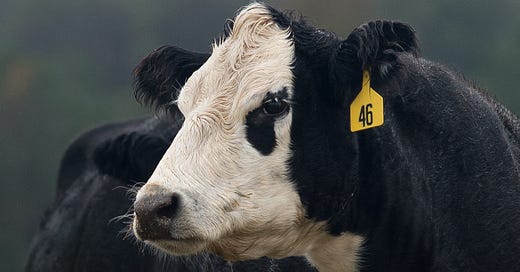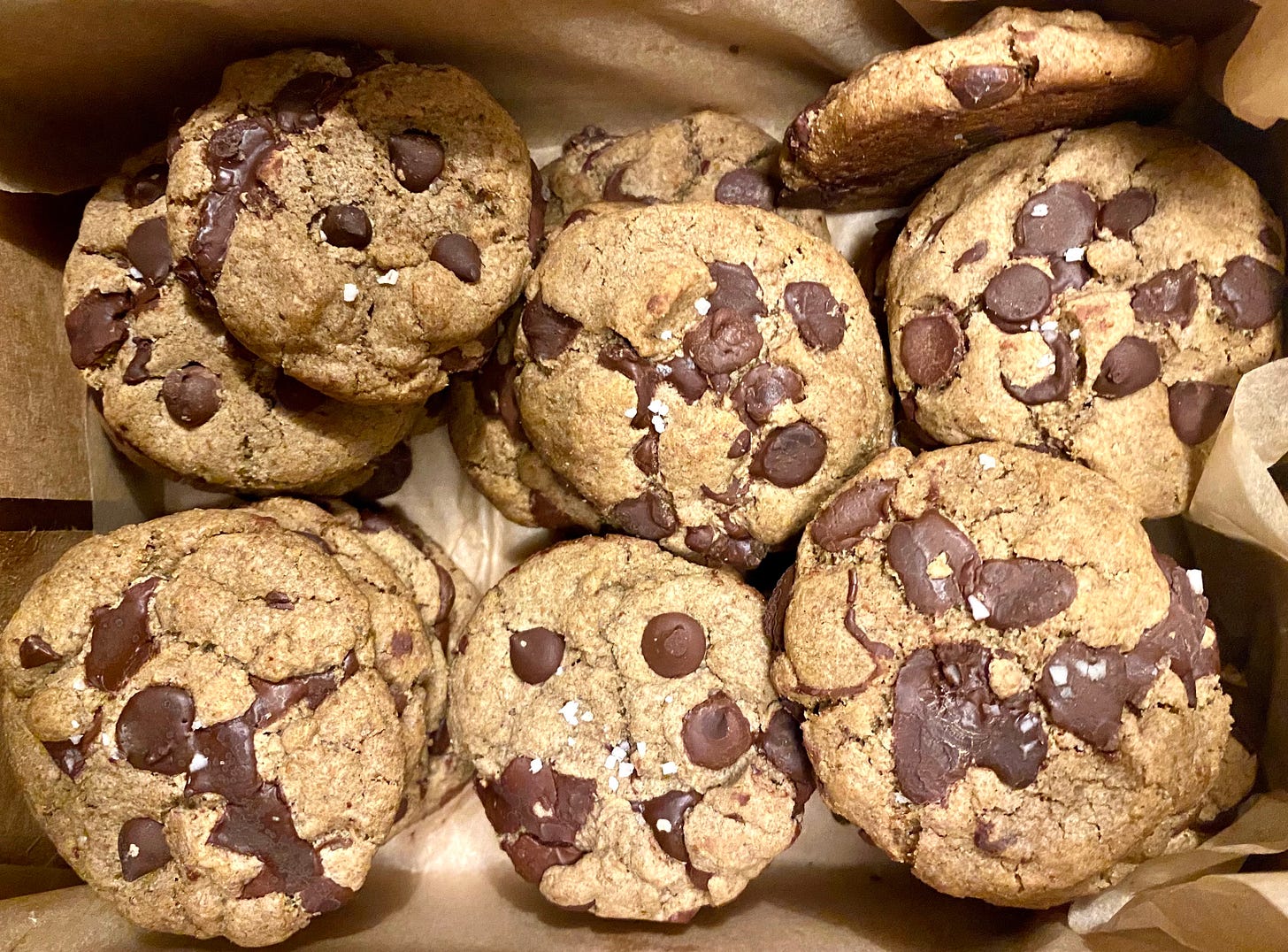At COP26, missed opportunities to cut food’s climate impacts
Could we AIM for immediate action, instead?
There’s been good and bad news coming out of COP26, the conference that may be humanity’s last chance to come together to slow global warming enough to avoid the most catastrophic outcomes. (You know, NBD.)
If all of the countries represented actually meet their new commitments on fronts like ending deforestation and financing of fossil fuels, one analysis found warming could be limited to 1.8°C, which is still above the goal of 1.5°C set in the Paris Agreement but is a major improvement compared to the actual trajectory we were on. However, independent scientists at Climate Action Tracker countered that finding, saying the pledges were short on concrete plans and that their projections still showed warming hitting 2.4 to 2.7°C.
Either way, one thing was clear: Decarbonizing the food system was barely on the table.
While fossil fuels are the number one cause of the climate crisis and should be the primary focus of efforts to address it, research now shows that it will be impossible to meet any of these goals without also cutting emissions from food production.
Last year, WWF published a report that found countries are missing serious opportunities to reduce greenhouse gas emissions by ignoring strategies like shifting to more plant-based diets and tackling food loss and waste and that “by adding them to national climate plans policymakers can improve their mitigation and adaptation contributions from food systems, by as much as 25 percent.”
Here’s what you need to know about what did (and mostly didn’t) happen to move the needle on food and climate at COP26.
Unwrapped
First, 105 countries, including the United States, signed the Global Methane Pledge, committing to cut methane emissions by 30 percent below 2020 levels by 2030. That’s a big deal because methane’s shorter-lived but powerful role in the climate crisis has become more apparent, and reducing emissions could buy us some time while we wait for gains from reductions in other greenhouse gases to be realized. However, emissions really need to go down 45 percent, and the four largest emitters—China, India, Russia, and Brazil—didn’t sign.
And what about food? The pledge focuses on methane leaks from oil and gas production, and a coalition of environmental groups said it essentially gives agriculture a free pass. As I covered in Civil Eats last month, agriculture is the number one source of global methane emissions, and animal agriculture (particularly beef and dairy) is the biggest contributor within farming.


While the Biden administration will regulate methane emissions from the oil and gas sectors as part of the US pledge, it’s focused on “voluntary adoption of climate-smart practices” in agriculture, such as improved manure management systems, anaerobic digesters, and new livestock feeds. As I’ve also covered before, this means money will flow to big meat companies to get them to make tweaks to their industrial systems, like building digesters to capture methane or adding supplements to cattle feed, while the other negative impacts of CAFO production remain. What it won’t do is regulate methane emissions from agriculture, initiate a shift to lower-impact systems, or invest in a transition to lower-meat diets.
“The Global Methane Pledge should put an emergency brake on global heating but the absence of a strong target on agriculture blunts its impact,” said Reyes Tirado, senior research scientist at the Greenpeace Research Laboratories at the University of Exeter in the UK. “Agriculture is the biggest source of methane from human activity and reducing livestock herds is a fast and effective way of cutting emissions. Governments need to get a grip on agricultural methane, including through measures to scale back livestock production.”
Beyond methane, at COP26, US Agriculture Secretary Tom Vilsack announced a new climate-and-agriculture initiative called Agriculture Innovation Mission for Climate, or “AIM for Climate,” in collaboration with the United Arab Emirates, “to significantly increase investment in agricultural innovation for climate-smart agriculture and food systems over five years.”
Great, except that again, while many countries signed on to participate, all of this is voluntary. And while some of the projects are advancing research in promising areas like changing land management to build soil organic carbon in Latin America and implementing regenerative practices on cotton fields in the US, the bulk of the projects are in collaboration with the very companies responsible for many of the food system’s biggest problems.
For example, CropLife International, the pesticide industry’s powerful lobbying arm that has fought regulation of toxic chemicals its members sell for years, will “accelerate access and uptake of climate-smart crop protections innovations for smallholder farmers in Asia, Africa, and Central America,” while the Bill & Melinda Gates Foundation will work on “climate-resilient” traits in crop genetics. These are the organizations that continue to push expensive seed and chemical inputs on farmers in the Global South (mostly for growing corn) rather than providing resources to programs seeding traditional crops that are both climate-resilient and nutritious.
And speaking of rarely respected foodways, indigenous groups attended COP26 to advocate for climate justice and food sovereignty, but those conversations mostly happened on the sidelines of the main event. As did events hosted by the UN’s International Fund for Agricultural Development, which had a schedule packed with conversations on the role of small-scale farmers and indigenous peoples in climate change adaptation and global food security. Other NGOs also hosted panels in conjunction with COP26 featuring businesses and advocates working at the intersection of food and climate.
Speaking from Glasgow, the Special Envoy for the UN Food Systems Summit, Agnes Kalibata (whose leadership you may remember is also controversial), said that while COP26 featured sessions on food issues, those issues were largely absent from Member State discussions and commitments. “There is no path to a 1.5 degree target without putting food front and center in our COP conversations. We must talk about food to address the climate crisis,” she said. “We must ensure food systems are adapting to climate change and resilient enough to continue nourishing people and advancing prosperity and equitable livelihoods.”
Kalibata called on the UN to “significantly ramp up attention to food and agriculture” at COP26 in 2022.” When it comes to climate, however, the consequences of one more year of inaction could be dire.
Currently Devouring
Crazy, or just crazy enough? In the past week, I got wrapped up in two compelling stories about climate innovation moonshots and whether or not they’re worth investing in. Neither are specifically about food, but hey, we can’t live and eat on this planet if we don’t stop warming, so… The first was a deep dive into nuclear fusion in The New Yorker, and the second was a critical look at carbon capture projects and their pros and cons in Mother Jones. They’re both long…and absolutely worth the reading time.
Still hungry?
Milk money. For Civil Eats, I wrote about drama unfolding in the organic dairy industry. In August, Danone, which owns Horizon Organic, ended milk contracts with 89 small dairy farms in the Northeast, prompting protests and attention from Congress. Advocates are convinced Horizon is shifting its sourcing to bigger, cheaper farms in the West; In an exclusive interview I did with a Danone executive, he said that’s not true. Either way, the future of organic dairy farming in the region is threatened, and the move prompted conversations about how to save it.
Actually eating
My lovely friends made me these unbelievable rye chocolate chip cookies for my birthday. These are special like me (ha), but if you’re jealous (you should be), you can check out and buy the incredible vinegars, misos, and soy sauce they make, by hand, using the most carefully sourced local ingredients. Someday I’ll get around to writing about their company in a real way.
Let’s be friends
Follow me on Twitter and Instagram to continue the conversation. See you next week!





